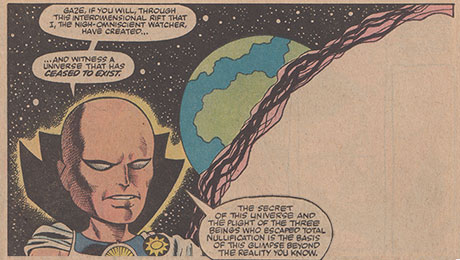
The Thin Black Line: Perspectives on Vince Colletta - Comics Most Controversial Inker
Doug: After several short sittings, I decided one Friday night (yeah, I'm that exciting...) to take a little plunge and finish the last half of this book. The TwoMorrows publication is authored by Robert L. Bryant, Jr., is 128 pages and retails for $14.95. And it's a page turner.
A couple of years ago, over on the Two Girls... blog, Karen and I participated in a review of Ronin Ro's Tales to Astonish tell-all about life in the Marvel Bullpen in the 1960's. That book was mainly focused on Jack Kirby. While full of anecdotal dirty laundry, our main complaint about the book was the lack of referencing for all of the information Ro provided. Bryant doesn't allow himself to slip anywhere near those depths of historical irresponsibility in this book. Whether a Colletta apologist or attacker, names are named and attached to every quote in the book. And, as in the case of Marv Wolfman and Jim Shooter, when certain principals chose not to comment we are told that they refused to comment. No, Bryant offers a balanced and attributable list of criticisms (both positive and negative) of those who knew Colletta throughout his career.
Among those creators prominently quoted in this exhaustively researched book are: Stan Lee, Carmine Infantino, Roy Thomas, Mike Grell, Mark Evanier, John Romita, Fred Hembeck, Joe Sinnott, James Sherman, Tony Isabella, Tom DeFalco, Herb Trimpe, Joe Staton, and many others. As I said above, some defend Colletta... but to be honest, most of this is a rip-job, some of the criticisms even sounding angry. There are two main criticisms: Vinnie's propensity to erase and/or ignore the lines that he did ink, and his speed. The latter is ironic, because it's what kept him in the industry when (if it's true) so many pencillers were unhappy with his embellishment. To provide balance to the many complaints, Colletta's son Franklin is often quoted, providing insight to the private Colletta -- family provider, friend to many, and a guy out to make a buck.
Perhaps the two stories that are included that are well-known (I'd heard the first of these claims) about Colletta's career are the oft-told charge that he threatened to throw Roy Thomas out a window of the Marvel offices, and testimony that Colletta could fully ink a page in 30-minutes or less.
I've provided the link to the TwoMorrows preview a couple of times. Rather than scan other pages from the text, I'll give it to you again. This is the entire chapter that covers his inks over Jack Kirby on Thor. Ironically, it's this work that many favor most among all of Colletta's output. It's interesting that John Morrow chose this chapter to provide as a selling point -- it's certainly the most inflammatory, as it showcases numerous examples of Colletta erasing the King's pencils. That being said, it's a sales hook. You should know that the book is a bit more balanced than that.
Here is the table of contents:
Introduction: The Debaters
Chapter 1: The Controversy
Chapter 2: Love, American Style
Chapter 3: Inking Asgard
Chapter 4: Rivets and Trees
Chapter 5: The Fourth World
Chapter 6: The Guy on the Assembly Line
Chapter 7: "You Could Always Use Vinnie"
Appendix: Two Years in the Life
Acknowledgments
The latter two sections make Bryant's book a real winner for me -- to show Vinnie's workload, he provides a synopsis of Colletta's work in two different years (1967 and 1977) and lists the Grand Comics Database as his resource. The acknowledgments section is a sort of bibliography and includes the names of those interviewed, when, and in what format.
Ronin Ro could learn a lot about writing history/biography from Robert Bryant.

















































1 comment:
Doug:
I'm looking forward to checking this book out. While I sometimes find a Colletta inking job that's not as bad as I remember, I'm having a hard time getting on board with the idea of reevaluating his work. While Colletta's speed was surely an asset to the publishers that hired him, he was usually no friend to the lover of comic-book art. He was one of the first creator credits I actually noticed when I was a kid, because of the negative impact of his work over pencilers I liked. Still, like I said, I'm looking forward to checking this one out.
(Note: There's another review of this book over at 20th Century Danny Boy. The author of that piece, Daniel Best, has some issues with Robert Bryant's methods. Here's a link to that review: http://ow.ly/2WL3D . I haven't bought and read the book yet, so I'm reserving judgment for now.)
Cheers,
Andrew
ComicsBronzeAge.com
Post a Comment